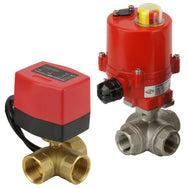Collection:3-Way Electric Ball Valves
Explore Tameson's wide range of 3-way electric ball valves from various global manufacturers. 3-way electric ball valves, also called 3-way motorized ball valves, are used to control the flow of... Read more
3-Way Electric Ball Valves

Explore Tameson's wide range of 3-way electric ball valves from various global manufacturers. 3-way electric ball valves, also called 3-way motorized ball valves, are used to control the flow of a media (liquid or gas) by means of a rotating ball with a bore. The rotating ball is controlled by an electric actuator that connects directly to the ball valve stem, rotating it a quarter turn. A 3-way electric ball valve can be broken down into two main components, namely, the electric actuator (servo motor) and the ball valve. 3-way ball valves have three ports. They are available in two design types: L-port and T-port. This refers to the bore design in the ball, which is the media flow path.
With a 3-way ball valve T-port or L-port, it is possible to mix, distribute, or divert the media flow. A 3-way T-port valve can be used for mixing media from two inlets into a single outlet or for distributing one inlet to two outlets. The 3-way L-port ball valve is designed for flow direction control. The L-port valve has a 90-degree bore inside of the ball, hence the name L-port. An example of an application is to have two inputs from separate tanks and one output, and you want to only use one of the inputs but always the one output. L-port ball valves can have 90-degree or 180-degree handles. Ones with a 180-degree turn allow you to disconnect both inputs from the output, allowing for no flow. Therefore, it is important to know your bore design to ensure your desired media flow, as the ports can be in different positions. The pressure inlet for 3-way ball valves is typically on the center borehole to avoid leakage unless defined otherwise in the product specifications. These motorized 3-way ball valves can be controlled remotely to switch between the circuits. If electrical voltage is already available, a 3-way control valve is a good investment to automate the process. Various materials like brass, stainless steel, and PVC are used in the construction of 3-way electric ball valves.
Zone valves, combined with 3-way electric ball valves, are essential for fluid control in HVAC systems, boosting energy efficiency and climate control solutions.






